Aztec Social Classes: Who's Who?
Aztec society was split into strict layers. You had the emperor at the top, nobles with all the perks, commoners doing the hard work, and slaves at the very bottom. But your place wasn't always set in stone... let's take a look.
A Job from the Gods
Paying the Gods
Aztec society was built around its religion. They believed the gods had sacrificed themselves to create the world, which put humans in constant debt to them. To repay this cosmic debt, the gods needed nourishment from human blood.
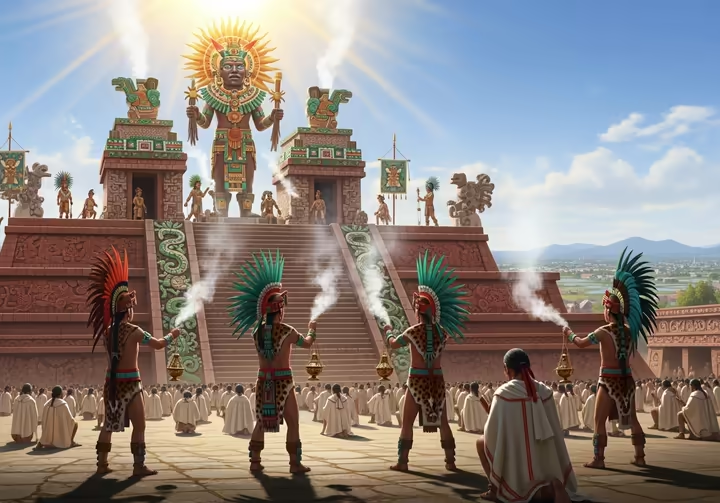
The sun god Huitzilopochtli especially needed this energy to keep the sun moving and fight off darkness. This made war and human sacrifice sacred duties for the empire's survival. The government's main job was organizing this whole operation.
Everyone Had a Role
This religious duty created the empire's main social split, the division between nobility ( pīpiltin ) and commoners ( mācehualtin ). The pīpiltin were chosen to lead armies and understand the gods' will. The mācehualtin provided the labor, goods, and soldiers to keep the empire running.
So, your job in society was also your job in the universe. The rulers and priests led, the farmers provided food and labor, merchants moved goods, and artisans made things. Everyone had a part to play.
The Ruling Class: The Pīpiltin
At the top were the pīpiltin , the hereditary nobles who ran politics, the military, and religion. This elite group was small-maybe five percent of the population. They lived a life of privilege, but it came with big responsibilities.
The Huey Tlatoani, or Emperor
The supreme ruler was the Huey Tlatoani ("Great Speaker") in Tenochtitlan. He was considered a semi-divine figure who spoke for the gods and commanded the army. His duties included managing tribute, judging major legal cases, and leading big religious ceremonies.

A new emperor often started a "coronation war" right away. This was a military campaign to capture prisoners for the sacrifices that proved he was the rightful ruler.
Noble Life: Perks and Duties
Below the emperor were high-ranking nobles ( tetecuhtin ) who ruled cities, along with top priests and army commanders. The whole pīpiltin class inherited their status and had special perks by law. They could wear fine cotton clothes with bright feathers, while commoners had to wear scratchy maguey fiber.
Nobles could also build large, two-story stone houses, unlike the simple adobe huts of commoners. They owned private estates and could have multiple wives to form political alliances.
But life as a noble wasn't all luxury, it came with serious duties. They had to serve the state as governors, judges, and military leaders. Their kids went to elite schools called the calmecac to learn history, law, and religion for these future roles.
Nobles also faced a stricter legal code. A crime committed by a noble was punished more harshly than the same crime by a commoner. This kept the ruling class in line.
The Common Folk: The Mācehualtin
Most people were commoners, or mācehualtin . They were the engine of the empire. Their lives revolved around the calpōlli , a kind of local clan.
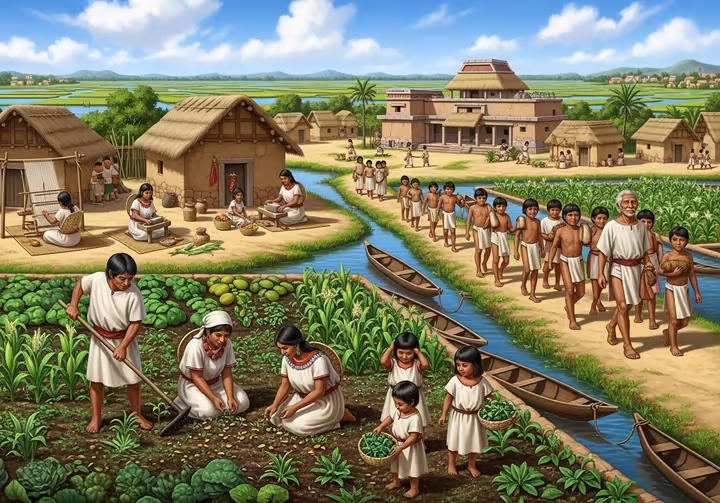
Life in the Calpōlli
A calpōlli (or "big house") was part family clan, part neighborhood, and part work crew. Each calpōlli was like a mini-town within a city, run by an elected chief and a council of elders. The clan had its own temple, a small market, and its own school for kids, the telpochcalli ("house of youth").
Tribute, Farming, and Fighting
A commoner's life had three main duties. First, paying tribute-they had to give a share of goods like crops and textiles to the state. Second was farming the communal clan lands to feed their families.
The third duty was military service. Every commoner man was a trained warrior, ready to fight. When war broke out, the men of a calpōlli fought together as a single unit.
In return, commoners had rights and a social safety net. They had land to farm and local leaders to handle justice. Best of all, every child got a free, mandatory education.
At the telpochcalli , boys learned military skills, history, and religion. Girls were taught separately in the cuicalco ("house of song"), where they learned ritual songs, dances, weaving, and cooking.
Specialists: Merchants and Artisans
Between the nobles and farmers were groups with special skills. The most important were the pōchtēcah (long-distance merchants) and the tōltēcah (master artisans).
Pōchtēcah: The Merchant-Spies
The pōchtēcah were a small but powerful group of traders. They had their own guilds, neighborhoods, god, and even their own courts. They were very exclusive.
Publicly, they ran trade caravans to get luxury goods like quetzal feathers and jade. Secretly, they were spies for the emperor. These "disguised merchants" would blend in to gather info on a city's defenses and wealth.
This work could make them as rich as nobles, but they had to be sneaky about it. They dressed like commoners in public to avoid challenging the real nobles.
Tōltēcah: The Master Artisans
The tōltēcah , or master artisans, were also highly respected. Featherworkers, goldsmiths, and mosaic artists were seen as cultural treasures. Their job title linked them to the Toltecs, an earlier civilization the Aztecs admired.
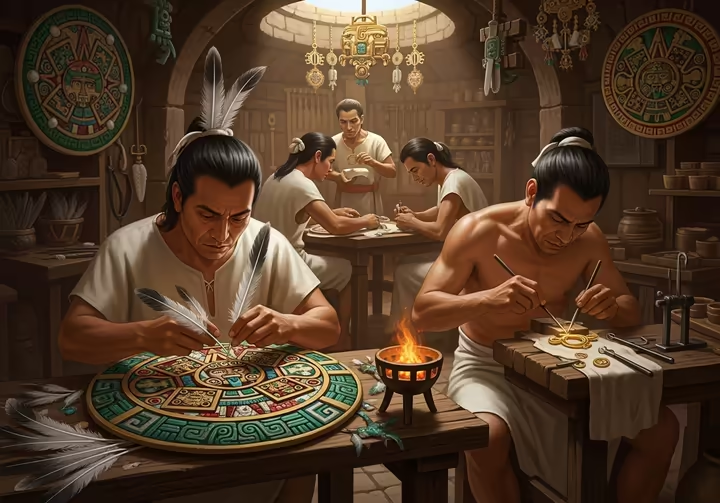
These artisans made the shiny symbols of power, like jewelry and headdresses. Though not as rich as the top merchants, they were well-paid and honored for their skills.
At the Bottom: Serfs and Slaves
At the bottom of society were people without the community rights of the mācehualtin . This group included rural tenants ( mayehqueh ) and slaves ( tlātlācohtin ).
Mayehqueh: The Serfs
The mayehqueh were farmers tied to the private land of nobles. Since they didn't belong to a calpōlli , they had no rights to communal land. They worked the nobles' estates and paid a large chunk of their harvest as rent.
Tlātlācohtin: Aztec Slavery
Aztec slavery was nothing like the slavery you might be thinking of. In the Aztec world, slaves ( tlātlācohtin ) were people with rights, not property.
You could become a slave as punishment for a crime, if you were captured in war, or by selling yourself to pay a debt. Critically, slavery wasn't passed down-a slave's children were born free. Slaves could even own property and other slaves.
A master couldn't sell a slave without their permission. There were also ways out of slavery. You could buy your freedom, be freed by your master, or even escape by running to the royal palace from the marketplace.
Moving On Up... Or Down
The Aztec social structure was rigid, but not completely locked. The empire's focus on war created a path for people to change their lives.
Climbing the Ranks in Battle
The best way for a commoner to move up was by being a great warrior. The goal in Aztec battles was capturing enemies for sacrifice, not just killing them. A warrior's rank depended on how many captives he took.
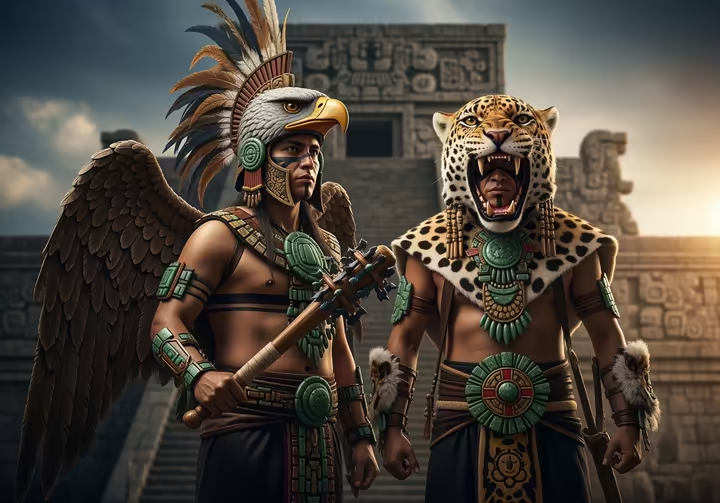
The highest honor was joining the Eagle or Jaguar warrior societies. By capturing four or more enemies, a commoner could join these elite groups and essentially become a noble.
These new nobles, called yāōtequihuah , got many of the same perks as the old ones. They were given land, allowed to drink pulque (an alcoholic drink), wear fancy jewelry, and eat at the royal palace. This system was designed to create a very motivated army.
Falling Down the Ladder
But you could move down, too. A noble who was a coward in battle or corrupt could be stripped of his rank. Since the law was tougher on the elite, the punishment was often severe.
A commoner could also fall in status. Failing to pay tribute, getting into debt, or committing a crime could land you in slavery. This meant status, even if inherited, had to be maintained.
Knowing Your Place
Social class dictated everything in daily life. You could tell a person's rank just by looking at them. Strict laws controlled clothing, housing, education, and even what you could eat.
The education system was split in two. Noble children went to the calmecac to learn how to be leaders. Commoner kids went to the telpochcalli to train as soldiers and workers.
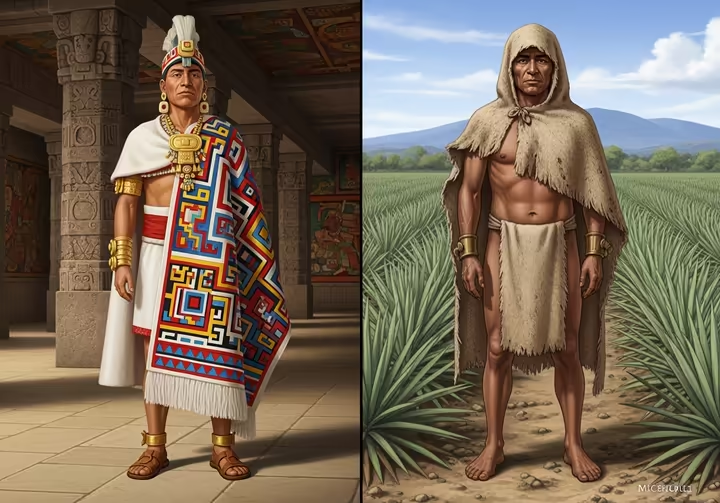
A noble's cotton cloak was a clear sign of his rank compared to a commoner's rough fiber one. Only the elite could build two-story stone homes or wear jewelry made of jade and gold. Even dinner was different, nobles could drink fancy cacao while commoners stuck to basics like maize and beans.
The legal system was also divided. Nobles faced a stricter code with harsher punishments, while powerful groups like the merchants had their own separate courts. These rules made sure everyone knew their place.